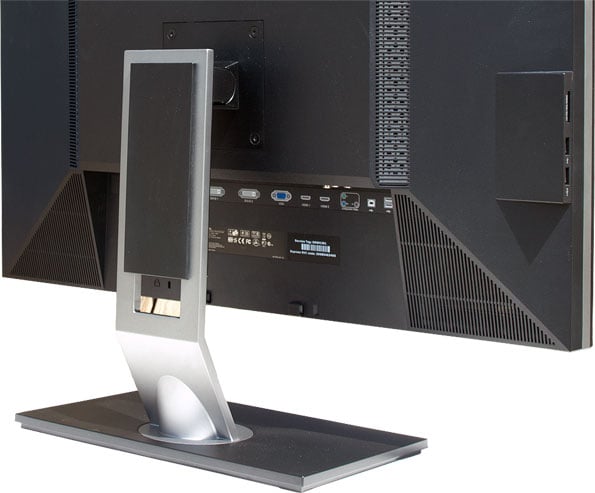Dell UltraSharp U3011 30-inch Monitor Review
Design

Dell released the U3011 before glossy finishes were all the rage. As such, the monitor sports a mostly black plastic design, the upshot being you won't have to spend any time wiping away finger smudges. There's also a metal strip that runs along the bezel, presumably to add a bit of sturdiness to the overall construction while giving it a subtle aesthetic accent. A reflective logo on the bottom of the bezel in the center is the only other piece of bling on an otherwise all-business looking monitor.
As we mentioned, the panel itself uses In-Plane Switching (IPS) technology. These cost more to manufacturer than the Twisted Nematic (TN) panels found on most monitors, but what you get in return are much better viewing angles and superior color accuracy. The U3011 features a 10-bit panel which, according to Dell's documentation, is capable of 12-bit internal processing (look-up table, or LUT). What this boils down to in layman's terms is the ability to display more colors per pixel.

The bezel width that runs along the front of the monitor is one mark shy of an inch on all four sides. Its depth is 1 and 5/8th inches if measuring just the frame itself and not the backside that holds the guts. On the left side it extends another 5/8th of an inch to accommodate the media card reader.
A solid, rectangular base holds the U3011 firmly in place. Combined with the monitor's weight, you're not going to accidentally knock the U3011 onto its side or off your desk, not unless you plow into it practicing a real-life barrel roll after seeing it done in Skyrim.
The stand allows you to make height adjustments (up to 90mm, or ~3.54 inches) to the monitor, which in this case is more about ergonomics than trying to find the ideal viewing angle. Since it's an IPS panel, you don't necessarily need a perfect line of sight, even when you're doing serious photography work. You can also make tilt (30 degrees) and swivel (3 degrees forward; 19 degrees back) adjustments, but it doesn't pivot to support portrait viewing. Drats.
Connectivity options abound on the U3011, which could very well be the deciding factor in choosing this panel over HP's ZR30w. All of the display inputs sit underneath the monitor. They include:
- DisplayPort
- Two DVI-D (dual link) ports with HDCP support
- VGA (D-Sub) connector
- Two HDMI 1,3a ports
- Component inputs
Other ports that run along the bottom include an AC power connector, DC power connector for attaching an optional Dell Soundbar, audio inputs, a USB upstream port, and two of the four USB downstream ports. Not pictured above is a Security Lock slot that sits on the back of the monitor, as well as mounting holes for the above mentioned Soundbar accessory.
By comparison, connectivity options on HP's ZR30w consist of a DVI-D port and a DisplayPort (as well as four USB 2.0 ports). Dell's U3011 clearly wins this round and gives you much more flexibility in terms of connecting multiple devices. You could, for example, benchmark a new PC using one of the inputs while doing work on another system and switch between them. When it's time for a mental break, you could then switch over to a connected Blu-ray player and blow your mind watching Crank 2.
The more devices you attach to the U3011 the greater the chances of creating a gnarly mess of wires, but to help wrangle them all in, there's a cable routing hole in the neck of the stand that's ready to swallow a fistful of cables.
Another advantage of the U3011 over the ZR30w is the inclusion of a 7-in-1 media card reader that Dell plopped on the left-hand side. This probably won't be a deciding factor for most people, but it's a nice bonus for users who choose this panel. The remaining two USB 2.0 ports sit next to the card reader.









